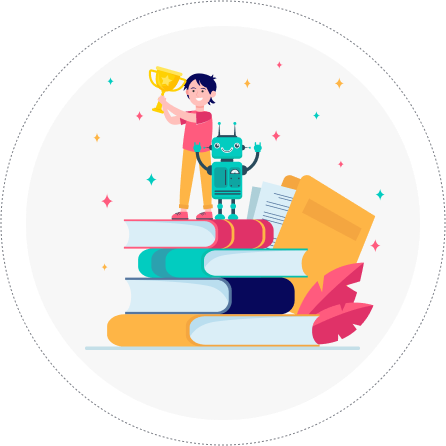R Programming
- Home
- / Python Handay
- / R Programming
Welcome!
R Programming is an open-source language and software environment designed for statistical computing, data analysis, and graphical representation. Widely used in data science, R provides tools for data manipulation, statistical modeling, and visualization through extensive libraries like dplyr, ggplot2, and caret, making it ideal for data-driven projects
Prerequisites
The prerequisites for learning R Programming include a basic understanding of programming concepts, familiarity with statistics and data structures, and a working knowledge of operating systems. Prior experience with another programming language or Excel can be helpful but is not mandatory. An interest in data analysis is beneficial
Learning Objectives
The learning objectives of R Programming include mastering data manipulation, visualization, and statistical analysis. Students will learn to work with R libraries, perform exploratory data analysis, create advanced visualizations, implement statistical models, and apply R in real-world data science projects.
Course Overview
- Introduction to R Programming
- Overview of R and its Applications
- Installation and Setup of R and RStudio
- Understanding RStudio Environment
- Basic Syntax and Commands in R
- Introduction to R Packages and Libraries
- Data Types and Structures
- Scalars, Vectors, Lists, and Matrices
- Factors and Data Frames
- Handling Dates and Times
- Operations on Data Structures
- Indexing, Subsetting, and Manipulation of Data
- Basic Operations and Functions
- Arithmetic, Logical, and Relational Operations
- Control Flow (if, else, for, while, repeat)
- Functions in R (Defining and Calling)
- Scoping Rules in R
- Built-in Functions vs. User-defined Functions
- Data Input and Output
- Reading Data from Files (CSV, Excel, JSON, etc.)
- Writing Data to Files
- Working with Databases (RMySQL, RSQLite)
- Web Scraping in R
- Importing Data from APIs
- Data Manipulation with dplyr and tidyr
- Introduction to dplyr and its Grammar
- Selecting, Filtering, Arranging, and Mutating Data
- Summarizing Data
- Data Transformation with Pipes (%>%)
- Reshaping Data with tidyr (gather, spread, separate, unite)
- Data Visualization with ggplot2
- Introduction to Data Visualization
- Understanding ggplot2 Syntax (Grammar of Graphics)
- Creating Various Types of Plots (Line, Bar, Scatter, Histogram, Boxplot)
- Customizing Plots (Themes, Labels, Titles)
- Faceting and Multiplot Layouts
- Saving and Exporting Plots
- Statistical Analysis in R
- Descriptive Statistics (Mean, Median, Mode, Variance, Standard Deviation)
- Probability Distributions (Normal, Binomial, Poisson)
- Hypothesis Testing (t-test, Chi-square test)
- Correlation and Covariance
- Linear and Logistic Regression Models
- ANOVA and MANOVA
- Advanced Data Handling
- Handling Missing Data (NA values, Imputation)
- Data Merging, Joining, and Binding
- Working with Large Datasets (data.table, ff, bigmemory)
- Working with Text Data and String Manipulation
- Time Series Analysis
- Introduction to Time Series Data
- Decomposing Time Series
- Forecasting Methods (ARIMA, Exponential Smoothing)
- Plotting and Analyzing Time Series Data
- Lagged and Differenced Series
- Machine Learning in R
- Overview of Machine Learning Algorithms in R
- Data Preprocessing for Machine Learning
- Supervised Learning: Regression, Decision Trees, Random Forest, SVM
- Unsupervised Learning: K-Means Clustering, Hierarchical Clustering, PCA
- Cross-Validation Techniques
- Model Evaluation (Confusion Matrix, ROC, AUC)
- Introduction to caret Package for ML
- Report Generation with RMarkdown
- Introduction to RMarkdown
- Creating Dynamic Reports
- Combining Text, Code, and Output in Reports
- Exporting to HTML, PDF, and Word
- Reproducible Research and Workflow
- Version Control with Git and RStudio
- Reproducible Workflow with knitr and RMarkdown
- Organizing Projects in R
Enquiry Now
Our Courses
Data Analyst using Python
Select Tech MindGuru for Why ?
Placement Assistance
Placement assistance offered for a successful career.
Membership
Membership provided until the final examination.
Personalized Attention
Personalized attention provided to each student.

Get Course Certificate
Certificate awarded upon completion of the course.
Monthly Tests
Regular monthly test series for progress evaluation.
Latest CBSE Syllabus
Training modules aligned with the latest CBSE syllabus.
Frequently Asked Questions
Typically, the course lasts 2 to 3 Months.
The course aims to teach data manipulation, statistical analysis, data visualization, and applying R in real-world data science tasks.
You can work as a Data Scientist, Data Analyst, Statistician, or Machine Learning Engineer.
Entry-level professionals can earn ₹4-8 lakhs per year, with experienced data scientists earning significantly more.
R is widely used in industries such as finance, healthcare, academia, research, marketing, and government sectors.
R is considered beginner-friendly, especially for those with a statistical or analytical background.
R continues to be a powerful tool in data science and statistical computing, with high demand in research and analytics.
Topics include data manipulation, visualization with ggplot2, statistical analysis, and machine learning with R.
R is often preferred for statistical analysis and visualization, while Python is more versatile for general programming and machine learning. Both are widely used in data science.


